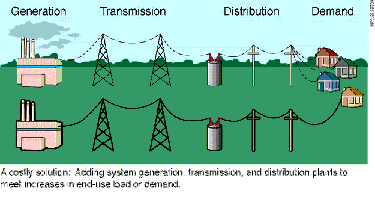
Benefits and Information
Distributed Resources
Electric utilities have historically satisfied customer demand by generating electricity centrally and distributing it through an extensive transmission and distribution network. As demand increases, the utility generates more electricity. Once demand increases beyond a certain level, however, the capacity of the generation, transmission, and distribution systems can become constrained. The traditional utility response to these constraints is to build new facilities (bold portion of the figure below).

An alternative is to satisfy demand locally and incrementally by investing in distributed generation. Distributed generation facilities are strategically sited to deliver electricity where it is needed, as shown below. This can relieve capacity constraints on the generation, transmission, and distribution systems and obviate the need to build new facilities as well as having a range of other distributed benefits.

Supporting Publications:
Identifying Distributed Generation and Demand Side Management Investment Opportunities
Distributed Generation: An Alternative to Electric Utility Investments in System Capacity
Also see our Online Documents page for other publications related to Distributed Power Generation.
The following graphic illustrates the benefits several utilities have received by distributing their resources.

This graphic was produced by QuickScreen Software, a planning tool designed to quickly find the best distributed-resource sites within a given electric utility and determine economic feasibility. The software package was produced by Pacific Energy Group (PEG). Additional information and a copy of the software can be obtained from PEG's Website.